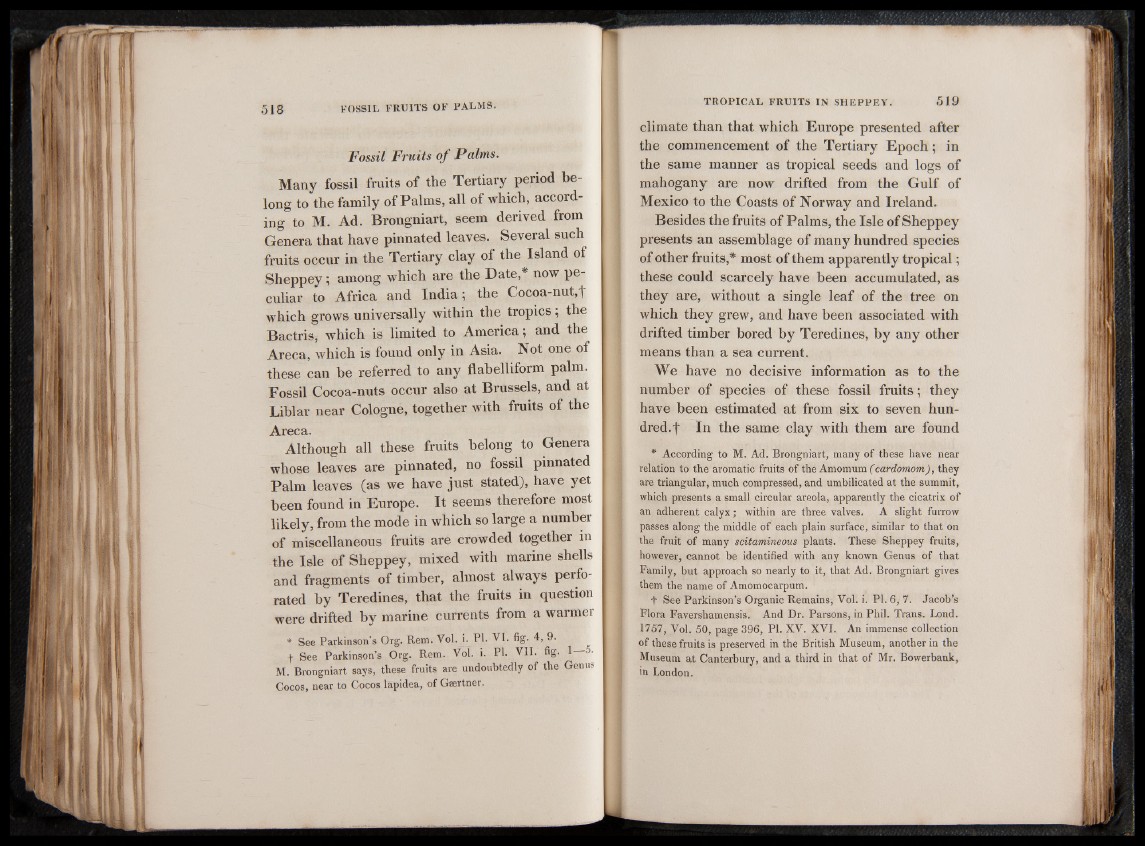
Fossil Fruits o f Palms.
Many fossil fruits of the Tertiary period belong
to the family of Palms, all of which, according
to M. Ad. Brongniart, seem derived from
Genera that have pinnated leaves. Several such
fruits occur in the Tertiary clay of the Island of
Sheppey; among which are the Date,* now peculiar
to Africa and India; the Cocoa-nut,|
which grows universally within the tropics; the
Bactris, which is limited to America; and the
Areca, which is found only in Asia. Not one ot
these can be referred to any flabelliform palm.
Fossil Cocoa-nuts occur also at Brussels, and at
Liblar near Cologne, together with fruits of the
Areca.
Although all these fruits belong to Genera
whose leaves are pinnated, no fossil pinnated
Palm leaves (as we have just stated), have yet
been found in Europe. It seems therefore most
likely, from the mode in which so large a number
of miscellaneous fruits are crowded together in
the Isle of Sheppey, mixed with marine shells
and fragments of timber, almost always perforated
by Teredines, that the fruits in question
were drifted by marine currents from a warmer
* See Parkinson's Org. Rem. Vol. i. PI. VI. fig. 4, 9.
f See Parkinson’s Org. Rem. Vol. i. PI. VII. fig. 1 5.
M. Brongniart says, these fruits are undoubtedly of the Genus
Cocos, near to Cocos lapidea, of Gsertner.
climate than that which Europe presented after
the commencement of the Tertiary Epoch; in
the same manner as tropical seeds and logs of
mahogany are now drifted from the Gulf of
Mexico to the Coasts of Norway and Ireland.
Besides the fruits of Palms, the Isle of Sheppey
presents an assemblage of many hundred species
of other fruits,* most of them apparently tropical;
these could scarcely have been accumulated, as
they are, without a single leaf of the tree on
which they grew, and have been associated with
drifted timber bored by Teredines, by any other
means than a sea current.
We have no decisive information as to the
number of species of these fossil fruits; they
have been estimated at from six to seven hundred.
f In the same clay with them are found
* According to M. Ad. Brongniart, many of these have near
relation to the aromatic fruits of the Amomum ( cardomom) , they
are triangular, much compressed, and umbilicated at the summit,
which presents a small circular areola, apparently the cicatrix o f
an adherent calyx; within are three valves. A slight furrow
passes along the middle of each plain surface, similar to that on
the fruit of many scitamineous plants. These Sheppey fruits,
however, cannot be identified with any known Genus of that
Family, but approach so nearly to it, that Ad. Brongniart gives
them the name of Amomocarpum.
t See Parkinson’s Organic Remains, Vol. i. PI. 6, 7. Jacob’s
Flora Favershamensis. And Dr. Parsons, in Phil. Trans. Lond.
1757, Vol. 50, page 396, PI. XV. XVI. An immense collection
of these fruits is preserved in the British Museum, another in the
Museum at Canterbury, and a third in that of Mr. Bowerbank,
in London.